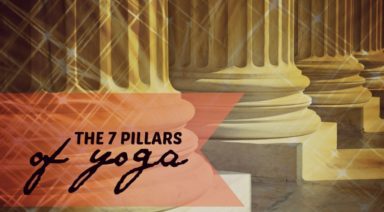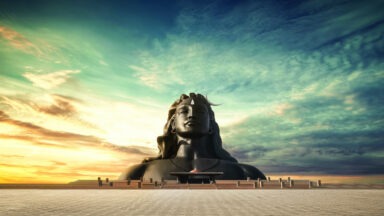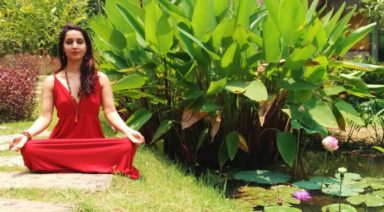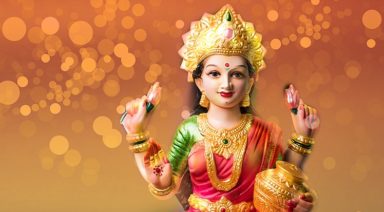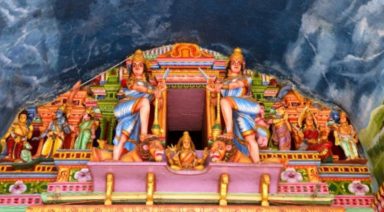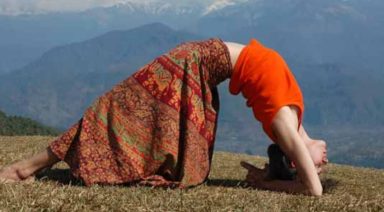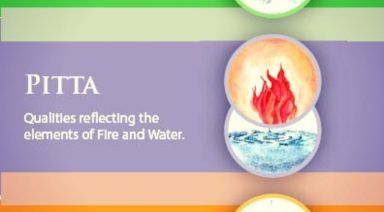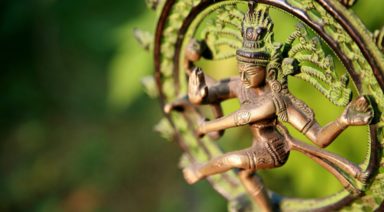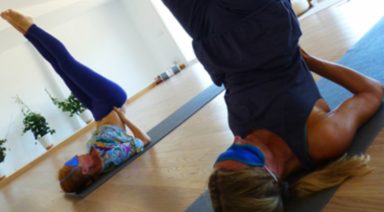How to Live with Purpose: The Eight Paths of Yoga

The word yoga is translated literally as union but there are so many different forms, types and practices in yoga that it can often seem confusing. Although the eight limbs of yoga and the eight paths of yoga sound similar, it’s important to differentiate them.
The eight limbs of yoga is explained in Patanjali’s Yoga Sutras as an eightfold path called ashtanga, which means eight limbs (ashta= eight, anga= limb). These limbs are suggestions for living a life full of purpose and meaning. They act as a compass for self-discipline, integrity, and connecting to the divine within ourselves as well as the world around us. They are: yamas, niyamas, asana, pranayama, pratyahara, dharana, dhyana and Samadhi.
The eight paths or forms of yoga are Hatha, Bhakti, Jnana, Karma, Tantra, Raja, Kriya, and Kundalini.
The eight paths or forms of yoga each incorporate at least one or more of the eight limbs of yoga. All forms are practices to accelerate the process of yoga, or what the Bhagavad Gita refers to as, “the science of creating union between the Individual Consciousness with the Ultimate Consciousness.”
Each yogic path essentially is a set of practices designed for a certain type of practitioner. While Karma yoga uses action and service, Bhakti yoga focuses on love and devotion as means of attaining union. Raja yoga is known as the yoga of concentration and Jnana yoga is the yoga of knowledge.
Different from the branches of yoga, explained in Ashtanga, the eight paths each have a unique history and origination. As a yoga practitioner, you might want to review the origin and meaning of each, try the exercises below and journal or meditate on the answers to determine which form you will choose to explore next. Remember, you can only master so many forms in a lifetime.
THE EIGHT PATHS OF YOGA
HATHA
The practice of asana, yoga postures, is commonly referred to as Hatha yoga. In Hatha yoga, the root, ha refers to the life, or pranic force, which governs the physical body. The ha root is also the audible sound of our last breath. The syllable tha denotes the mind, or citta force. With practice, Hatha yoga awakens the physical and mental forces that regulate our lives. In addition, the body systems are balanced and purified and the mind is prepared for the focus necessary to clear blockages in our energy centers, or chakras, and the practice of accessing the kundalini energy within us.
Higher states of awareness and meditation become available through the subtleties of refining one’s personality through asana, breathing, energy locks, mudras, and physical/mental detox techniques.
EXERCISE
Hatha yoga is the root of the physical practice; using a journal, describe five points or postures in which you feel most grounded, or rooted.
BHAKTI
Bhakti is a yogic practice of love and devotion/complete faith. Faith is in the recognition that there is divinity or supreme consciousness in any form: Lord Rama, Krishna, Christ, Mohammed, Buddha, a Guru for his disciples, etc.
Followers of the Bhakti practice experience an emotional connection with the form of faith recognized.
Through the free flow of energy, chants/songs or sound currents, Bhakti yoga releases mental and physical disorders often caused by people’s tendency to suppress emotions.
EXERCISE
As a practice of love and heart centeredness; using a journal, describe that to which you are devoted. If you’re unsure, look at what prioritizes your time. In addition, search for a song or chant that aligns with your devotion.
JNANA
This is the yoga of knowledge becoming wisdom. This type of yoga calls to mind the inscription on the temple of Apollo at Delphi, that says “Know thyself”.
Some components of Jnana yoga include: moving beyond the notion of belief into what’s referred to as ‘realization’; introspection as a practice of self-awareness and self-analysis; the experience of knowledge; intuitive wisdom and inner unity. When we know and understand our own personal patterns through self-analysis, we’re able to recognize them in others. This leads to unity through the bridge of compassion.
Jnana yoga provides the practice to transform intellectual knowledge into wisdom.
It’s a pathway by which one recognizes the personal as an integral element of the universal: one discovers how their life purpose, or dharma, relates to the universe.
JNANA EXERCISE
Write five responses to the question, “Who am I?” Further the writing by identifying these elements in others and the world.
KARMA
This is the yoga of action and service, a path of devotion to the work. The goal is to transcend one’s identity through the efforts of selfless work. There’s an emphasis on non-attachment with the work and becoming an instrument of the divine, or a ‘clear channel’.
The essence of Karma yoga as extracted from the Bhagvad Gita says: “The world confined in its own activity except when actions are performed as worship of God. Therefore one must perform every action sacramentally and be free of your attachments to the results.”
KARMA EXERCISE
Write five ways in which you can be of service, followed by five action steps (adding a time frame or date by which to complete is useful).
TANTRA
The word tantra means to weave or expand. The purpose of Tantra yoga, is a deeper connection with others and the universe through the process of merging spiritual styles, teachings, and various yoga practices. The Sanskrit word tantracomes from the words tattva, the science of cosmic principles, and mantra, the science of sound vibrations.
TANTRA EXERCISE
Weave the elements of a tantric home practice by blending your favorite mantra or chant with movements and postures. Allow yourself the freedom to explore and create.
RAJA
Raja is the yoga of concentration, a system of yoga based on eight stages described in Patanjali’s yoga Sutras. The practice of Raja yoga embodies the yamas (restraint) and niyamas (disciplines) to purify practitioners; the asanas (postures) and pranayamas (breathing techniques) to uplift vitality and health; pratyahara (sensory withdrawal) and dharana (concentration) to create balance of mind and emotions; dhyana (meditation) and samadhi (absorption in the universal identity) to develop consciousness. The root raj means king.
Practicing Raja yoga enables the practitioner to reign over the kingdom of their mental, emotional, physical and spiritual existence and find balance in the whole of existence.
RAJA EXERCISE
Using a journal, elaborate on what it might look like for you to sustain a state of balance both in your individual state and as that relates to the world around you. Might you behave differently at work or at home? Or towards others in traffic?
KRIYA
The word kriya means action or movement and refers to both physical activity as well as movement of energy and awareness. Kriya also refers to the result of the practice: total union that occurs from the purposeful actions and awakening in consciousness. The harmony of mental, physical and energetic faculties promotes a state of evolution into one’s highest potential. Only 20 or so of the over 70 kriyas in the full form of Kriya yoga are commonly known. These practices are written in Sanskrit, inscribed in numerous tantric texts. Only a few of these have been translated into other languages.
KRIYA EXERCISE
What do the phrases, “purposeful actions” and “awakening consciousness” mean to you? How might you gain a greater understanding and embodiment of these?
KUNDALINI
This system of yoga is concerned with awakening of the energy centers or chakras, which exist in every individual. Asanas, pranayama, mudra and bandha (conscious engagement and release of energy locks) and other forms of yoga such as Mantra yoga are used to stimulate the awakening. The availability of Kundalini yoga in the West is attributed to Yogi Bhajan, who courageously introduced the practice to the United States and Canada in the 1960’s.
Kundalini practices and kriyas aid in releasing kundalini energy that rests at the base of the spine and distributes throughout the body by way of the chakras. Glandular systems and neurological functions are enhanced with the practice. All elements, including the specific angles at which the body is positioned in various kriyas are all intentional in furthering the overall health and well being of the practitioner.
KUNDALINI EXERCISE
Kundalini yoga is becoming increasingly available. Seek out a yoga studio that offers Kundalini yoga as taught by Yogi Bhajan or practice alongside videos available online.
Regardless of which type of yoga you currently practice, stay curious and keep exploring other forms.
Satya: Truth in Practice

Learning any new language can expand the limits of our experience by giving us different ways to articulate an idea or a feeling. What follows is a new set of pathways for relating to others, ourselves, and the world.
The limits of my language are the limits of my world. ::Ludwig Wittgenstein
Satya Defined
Sanskrit is an intrinsically vibrational language that aims not only to promote understanding and communication, but to awaken consciousness on all levels of being through sound that is inextricably connected to form. As we explore the definition of any Sanskrit term, we must acknowledge the inevitable deficiency that will result as we attempt to derive meaning from a single word, particularly a written word, used thousands of years ago. What we can do is study the language as a raw clay from which we shape a more intimate understanding. We can examine pieces of a whole and make a concerted effort to understand each one individually, building an awareness that is stronger than any definition we might glean from the amalgam alone. For example, an English to Sanskrit dictionary might yield the following for the word satya:
सत्य satya /suht-yaa/ adj. true; n. truth
This definition is sufficient if our interpretation of the English words “true” and “truth” come layered with the due richness of satya. The more likely scenario is, they do not. Instead, let us break it down one step further, satya comprises the root word sat and the activating suffix -ya.
सत् sat — true, pure, virtue, unchangeable, absolute, that which is, supreme consciousness य -ya — coming from, as a result of
What is revealed etymologically is that satya is more than a dualistic examination of something as merely true or false. Satya is the state of being that arises when we operate from our highest (pure) consciousness.
There is a concept in linguistics termed the Sapir-Whorf hypothesis which posits that the language we speak influences the way we think and in effect, the way we act. At the very least, a deeper study of the Sanskrit word satya will give us a new way of thinking and feeling about the truth, perhaps one that bypasses our tendency to intellectualize and instead resonates with our deepest, instinctual consciousness.
Beyond a Shadow of a Doubt
For a practical example of satya, we can turn to nature. Consider a mountain, for instance. If possible, one that you are exposed to on a regular basis. In fact, any prominent geological feature will do, but let’s stick to the mountain for this example. You know this mountain exists because you have visual evidence. You have seen it from different angles. You know and understand its size and its shape. This evidence is confirmed externally by the fact that others have also seen this mountain and describe it in a similar way. Perhaps this mountain has a name and is used for directional guidance or maybe you have flown over it in an airplane. You may have even climbed this mountain and experienced it through your senses, validating its existence beyond any shadow of a doubt.
Then, one day, you wake up and there is a dense fog in the air. A fog so opaque, you can no longer see the mountain. You ask around for confirmation and find that no one else can see the mountain either. You might venture out to climb mountain again, but with the fog so thick, it is difficult to orient yourself and near impossible to confirm the presence of the mountain. Still, you know it is there. You have a memory of it and you can feel the incline of the earth beneath you. Despite confusion and what might even be considered evidence to the contrary, you have a deep knowing that the mountain still exists. The fog could linger for days or weeks, obscuring the mountain from immediate view. You may even forget about it, but the mountain never goes away. And on the next clear day, you might find yourself elated to see the mountain again. It will likely appear more magnificent than you remembered when the fog has lifted.
Satya works in the same way as the mountain. It is an inner knowing and experience of the truth, something believed beyond a shadow of a doubt. Whether a truth about ourselves or the universe, or simply an intuitive gut check that helps us make decisions, we each have a set of core values and beliefs that inform our thoughts and behaviors.
Be Kind
Satya is offered in the Yoga Sutras as the second of five yamas, which are often misguidedly referred to as restraints or “right living” rules. Nischala Joy Devi however, describes them as “reflections of our true nature” because our true nature is inherently good. The yamas can be thought of as behaviors that reflect our innermost essence.
To understand satya as one of the yamas, it is important to know that it comes after ahimsa by design. The yamas are not mutually exclusive, they are interdependent and there is an element of hierarchical balance between them. In that hierarchy, ahimsa (kindness) always comes first. This is particularly important to remember as we determine when and how to speak the truth.
Let your speech be true and sweet. ::Sri T. Krishnamacharya
The Four Gates of Speech
As a guide, the Four Gates of Speech, which evolved from the third action in the Noble Eightfold Path of Buddhism, offer a litmus test for delivering spoken words.
- Are they true? Beyond the factual verity of your words, they must be spoken with intention and clarity. A lie, no matter how trivial, disconnects us from higher consciousness and creates an entry point for self-doubt – if we know we are capable of lying, we lose the ability to trust ourselves and our instincts.
- Are they necessary? Consider whether your words add value to a given situation or whether it might be prudent to listen instead.
- Is it the right time? Take a moment to understand whether the person you are speaking to is ready to receive your words. Be patient if the timing isn’t right, your message will land most gently when it is.
- Are they kind? Finally, and perhaps most importantly, be kind. Ahimsa is offered as the first yama to be observed above all others and the last gate of speech as a final checkpoint before we are cleared to speak. Words without kindness are unconstructive, even when engaging in challenging conversations. If your words cannot be delivered from a place of kindness, go back inside and evaluate how you might identify words that better reflect your true nature.
Satya only exists in the present
The past, by its very nature, is a memory, and memories are faulty at best. A memory is formed when a lived experience is subsequently stored in the intricate archives of the mind. During this process, the experience undergoes systematic alteration as a result of our implicit and explicit biases, our mental and emotional states, and how closely we are paying attention. Despite our best efforts to recall the truth, the output is inevitably flawed.
Similarly, the future only exists as a prayer, a plan, or an expectation. When dealing with the future, there is always some degree of uncertainty. It has not yet come to be and therefore cannot be true. Satya only exists in the present and the practice of satya is a gradual calibration of our awareness to the fullness of each passing moment.
Satya on the Mat
Truth in practice begins before we unroll. It is present when the call to practice arises and when we commit to showing up on the mat. Truth perpetually invites us to practice wisely, from invocation to savasana. And when we say yes, we step into satya. So, what exactly does that mean as a yoga practitioner?
Breath is Guru
I say this all the time, but to really believe and practice it, is an expression of satya in Yoga. Breath is the teacher and as the student, you are the one being breathed. This is a sacred relationship and the underpinning of sustainable practice. Develop an internal system of checks and balances for monitoring your breath (like counting, or ujjayi) and adjust accordingly throughout your practice.
Ditch the i-Maker
The i-maker, ahamkara, is the tendency to over-identify with fleeting thoughts and sensations. When left to its own devices, the i-maker, fueled by the ego, will use the mat as its own private playground.
For example, consider this inner dialogue, brought to you by the i-maker, “Wow, my balance is really off today…I can’t hold half-moon…why can’t I hold half-moon?…I always hold this pose…it’s probably because I missed class yesterday…I should have come to class…I was so lazy…everyone else is holding the pose…I am a terrible yogi…I am not even a yogi at all…why can’t we just move to the next pose?…I hate half-moon…I am so over this class…did he just say “inhale”…am I even breathing?…I have to hold this or I won’t get better…seriously why can’t I just stay in the pose!?”
Now, enjoy the same conversation, but with a tone of satya, the ultimate antidote to the i-maker, “Wow, balance is challenging today…that’s interesting…maybe I’ll try breathing into the wobbles…looking at the floor seems to help…I’ll do that…[ breathes ]…how did I know to do that?…[ breathes ]…is that Yoga?…[ breathes ]…[ breathes ]…it was hard to concentrate during the opening meditation too…[ breathes ]…I haven’t really slowed down at all today…[ breathes ]…[ breathes ]… I think I’ll rest instead… [ breathes ].”
Don’t Sacrifice the Person for the Pose
Yoga is a whole-body practice and the purest expression of each pose is designed to recruit all parts of ourselves. When we ignore or even violate any part of the whole for the sake of the pose, we have lost the integration, the union and the Yoga. Satya is absent. If the pose comes first, we might be inclined to ignore the subtle signals from the body and push beyond the intelligent edge. As a result, the body will signal more loudly in the form of pain or injury until we are unable to ignore it. Instead, treat the pose as a lens through which you can see something new inside the person. The shape provides a direction, not a destination.
Satya also means resting before we get tired. When we know we are tired and yet, we still complete another chaturanga in a way that compromises shoulders or spine, it is a physical untruth. When we continually override the body’s natural rhythm in this way, it becomes more difficult hear when it is asking for rest. Listen and surrender as needed.
Look No Further than the Four Corners of Your Mat
Satya arises from the inside out and seeking validation or comparison from any external source will inhibit honest expression in practice. We cannot change our internally experienced reality with externally directed attention. Everything we need to observe is happening within the four corners of the mat, our focus need not be elsewhere.




